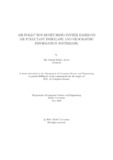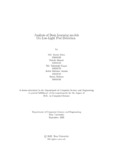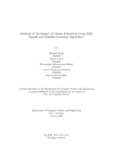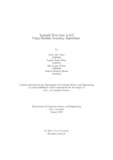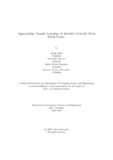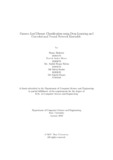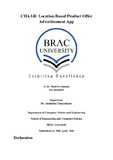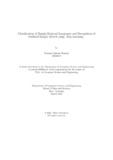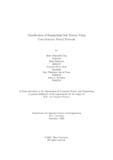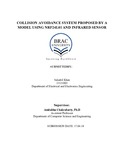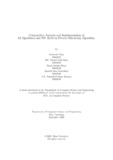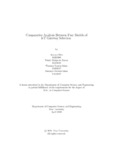Browsing by Author "Chakrabarty, Amitabha"
Now showing items 1-20 of 136
-
Advanced task scheduling algorithm for IoT Based FOG communication model
Mohammed, Zaber; Chowdhury, Riham; Rozario, Stanley Dip; Sakin, Sayed Bin Amirul (Brac University, 2020-04)Internet of Things (IoT) is hugely dependent on Cloud Computing. Cloud comput- ing uses a high degree of polymerization calculation mode and so it cannot ensure e ective use of resources like computing, storage, etc. FOG ... -
Advancing autonomous navigation: YOLO-based road obstacle detection and segmentation for Bangladeshi environments
Mahmud, Ishtiaque; Ritu, Sumaia Arefin; Mahmood, Zaki Zawad (Brac University, 2024-05)The advancement of autonomous vehicles requires a fast and effective object detection and segmentation system handling a wide range of road environments. The goal of this research is to improve autonomous navigation by ... -
Air pollution monitoring system based on air pollutant index(API) and geographic information system(GIS)
Auvee, Md. Samiul Bashar (BRAC University, 2019-05)Air pollution is the most alarming fact in modern world. Air pollution monitoring system is common research eld with tremendous new information which can be used to nd out the main air pollutants. In this research the ... -
An algorithm for minimizing number of collisions in highways using swarm intelligence
Chaity, Narjis Mostofa (BARC University, 2017-09-14)Road safety is a climbing inquiry everywhere throughout the globe these days. Research directed with respect to this issue utilizing different methodologies. Swarm robotics is a promising methodology portrayed by vast ... -
Analysis of deep learning models on low-light pest detection
Irtiza, Md. Samin; Ahmed, Fattah; Haque, Md. Tahmidul; Tamim, Arifur Rahman; Sultana, Samia (Brac University, 2022-09-28)It is undeniable that in recent years, exceptional progress has been made toward building the most accurate and efficient object detectors. However, existing low- light object detectors still require a substantial amount ... -
Analysis of the impact of online education using EEG signals and machine learning algorithms
Hoque, Ehsanul; Ahmed, Tausif; Shabab, Mohammad Adituzzaman; Bakhtier, Tahsin Mohammad; Abdullah, Sayeem Md (Brac University, 2021-01)Online learning has allowed students from different walks of life to access a vast amount of information, allowing them to gain new skills. However, only having access to that information does not mean that the students ... -
Anomaly detection In IoT using machine learning algorithms
Arko, Aritro Roy; Khan, Saadat Hasan; Preety, A a Anjum; Biswas, Mehrab Hossain (Brac University, 2019-08)Internet of Things (IoT) is growing as one of the fastest developing technologies around the world. With IPv6 settling down, people have a lot of addressing spaces left that even allows sensors to communicate with each ... -
Approaching transfer learning to identify correctly worn facial masks
Sadid, Tausif; Hossain, Md Sadik; Sengupta, Sudip Kumar; Khondaker, Serazam Munira (Brac University, 2021-06)Climate change has made the outbreak of diseases, especially airborne and contagious diseases much more extreme. Therefore, wearing masks has become essential in protecting ourselves not only from very common airborne ... -
Automatic motor vehicle number plate recognition
Saha, Krishno; Ishrak, Parvez; Shovon, Jahid Hossian; Abir, Alinur Rahman (Brac University, 2024-01)The purpose of this initiative is to develop automatic motor vehicle number plate recognition (Bangla) using machine learning, identifying and taking out the numbers of license plates from photos. By using this system ... -
Automatic slice growing method based 3D reconstruction of liver with its vessels
Alom, Md. Zahangir; Mostakim, Moin; Biswas, Rubel; Chakrabarty, Amitabha (© 2014 Institute of Electrical and Electronics Engineers Inc., 2014)In the recent years, reconstructing 3D liver and its vessels from abdominal CT volume images becomes an inevitable and necessary research field. In this paper, a method of 3D reconstruction of liver with its vessels has ... -
Best 11 selection using machine learning
Anik, Aminul Islam; Yeaser, Sakif; Hossain, A.G.M. Imam (BRAC University, 2018-04)Cricket has become the most popular game not only in Bangladesh but also around the world. Day by day it is gaining more people’s attention. The name and glory of team Bangladesh has trespassed the country’s border and it ... -
Bitcoin price forecasting based on historical data
Roy, Shaily; Nanjiba, Samiha (BRAC University, 2018-07)Over the past few years, Bitcoin has been a topic of interest of many, from academic researchers to trade investors. Bitcoin is the first as well as the most popular cryptocurrency till date. Since its launch in 2009, it ... -
Bone age comparison using convolutional neural network
Nawaz, Fariha; Akib, Md. Samiul; Imtiaz, Asif; Ahmad, Sakib Uddin (BRAC University, 2019-04)In the last few years,Machine Learning has taken the world by storm. From predictive web browsing to the email and text classi cation,from the autonomous car to facial recognition, machine learning is the main core of ... -
Cassava leaf disease classification using deep learning and convolutional neural network ensemble
Shahriar, Hasan; Shuvo, Protick Sarker; Fahim, Md. Saidul Haque; Sordar, Md Sobuj; Haque, Md Esadul (Brac University, 2022-01)Cassava is a high-protein and nutrient-dense plant, notably inside the leaves. Cassava is often used as a rice alternative. Pests, viruses, bacteria, and fungus may cause a variety of illnesses on cassava leaves. This ... -
CHAAR: location based product offer advertisement app
Sunnat, S. M. Mohi-Us (BRAC University, 4/18/2016)Shopping is a major part of this modern era for both Men and Women. CHAAR App dynamically helps the users to find out their desire and favorite products. Besides it will give the notification about the shops which will ... -
Classification of Bangla regional languages and recognition of artificial Bangla speech using deep learning
Hossain, Prommy Sultana (Brac University, 2022-03)Since 1970, researchers have been attempting to recognize and comprehend spontaneous speech. For an automatic voice recognition system, many techniques were employed. People always choose English for voice recognition ... -
Classification of Bangladeshi soil texture using convolutional neural network
Raj, Hafiz Mohiuddin; Shahreen, Sazia; Shah, Muntaha Binte; Evan, Syed Washinur Ashraf; Abdullah, Juhayer (Brac University, 2022-09-29)In agriculture, soil is one of the most potential output sources. That is why, if we can foresee the soil’s nature and how it will turn in the future as well as it’s other qualities, we may achieve adequate monitoring ... -
Collision avoidance system proposed by a model using NRF24L01 and infrared sensor
Khan, Salsabil (BRAC Univeristy, 2018-04-17)Vehicular accident is tremendously increasing day by day around the world, especially in small and large urban areas. The resulting collision has become a key issue and emergency as a recent research topic in automation ... -
Comparative analysis and implementation of AI algorithms and NN model in process scheduling algorithm
Niloy, Maharshi; Moni, Md. Moynul Asik; Khan, Farah Jasmin; Chowdhury, Aquibul Haq; Juboraj, Md. Fahmid-Ul-Alam (Brac University, 2022-09-28)Process scheduling is an integral part of operating systems. The most widely used scheduling algorithm in operating systems is round-robin (RR), but the average waiting time in RR is often quite long. The purpose of this ... -
Comparative analysis between four models of IoT gateway selection
Ritu, Ananya; Tanha, Pohali Mahjabin; Islam, Wasema Nooren; Islam, Sumaiya Ferdous (Brac University, 2020-04)The “Internet of things” (IoT) is a leading sector of technology where usual analog devices can be turned into smart devices with embedded systems and sensors. These devices can communicate with each other without requiring ...



